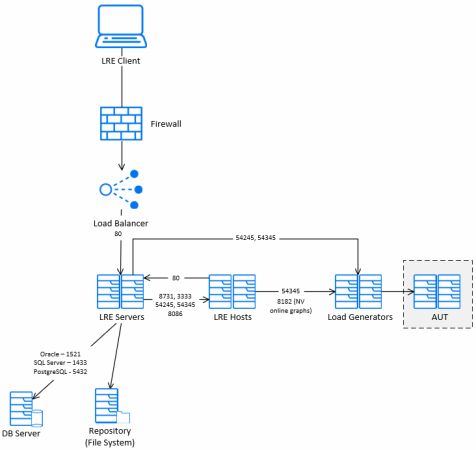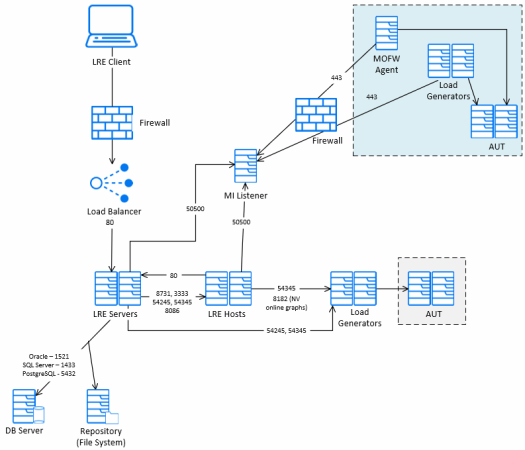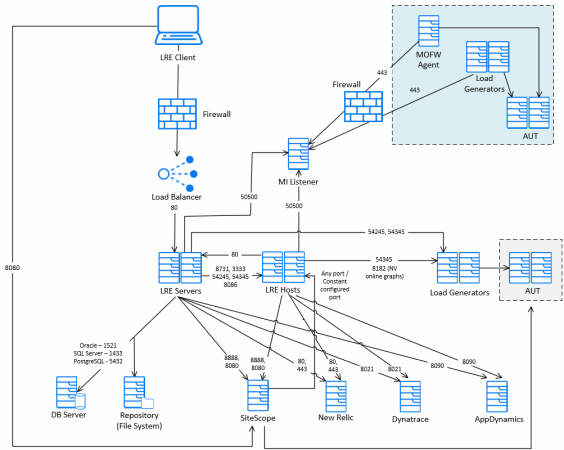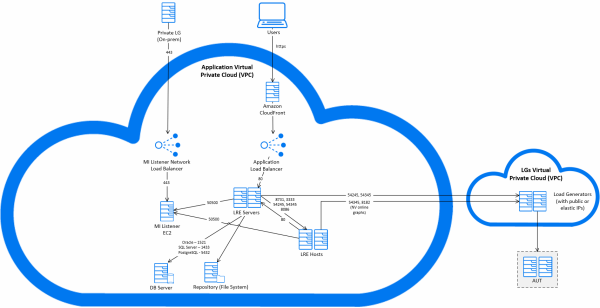Deployment examples
This section contains examples of some of the deployments that can be used for configuring LoadRunner Enterprise on-premises or on the cloud.
Note: These examples are used to illustrate functional capabilities only. In a real deployment, you can mix and match components to create a deployment plan that best suits your needs.
For full installation and configuration instructions, see the LoadRunner Enterprise Installation Guide (available from Installation).
Basic deployment example
The basic deployment for LoadRunner Enterprise requires a LoadRunner Enterprise server, LoadRunner Enterprise host, load generators, and LoadRunner Enterprise back end components (including LoadRunner Enterprise database and repositories).
Note: A load balancer is required only when you have two or more LoadRunner Enterprise servers.
Over firewall deployment example
When testing applications that are located behind a firewall relative to the LoadRunner Enterprise server or host machine, you must configure an MI Listener, a load generator over a firewall, and possibly a monitor over a firewall.
Advanced deployment example
This deployment illustrates the ability to integrate LoadRunner Enterprise with different Application Performance Management (APM) tools such as New Relic, Dynatrace, and AppDynamics. You can also integrate with Kubernetes for dynamic provisioning of load generators (see Dockerized host deployment example below).
Load generator cloud deployment example
LoadRunner Enterprise enables provisioning of load generators in the cloud using your cloud account. Load generator provisioning is supported with Amazon EC2 and Microsoft Azure cloud accounts. For more details, see Manage elastic cloud hosts.
Note:
-
The ports used in this diagram are the common HTTP ports. You can configure the cloud load generator ports as required.
-
For the most secure load generator connectivity, use TLS (SSL) with a client certificate.
Full cloud deployment example
You can deploy the full LoadRunner Enterprise installation (on-premise LoadRunner Enterprise server, hosts, and load generators) on your cloud provider platform as long as it meets the requirements in the Support Matrix and the correct ports are open. For more details, see Provision elastic cloud load generators.
Note:
-
To improve performance, it is preferable to deploy the LoadRunner Enterprise servers and hosts, and the database in the same region.
-
The required ports must be open for incoming requests to the relevant server.
-
Cloud load generator ports are configurable. When all the components are in the cloud, the ports to use are defined by the cloud provider (they are not based on internal IT policies).
-
For the most secure load generator connectivity, use TLS (SSL) with a client certificate.
Dockerized host deployment example
LoadRunner Enterprise enables provisioning Dockerized (elastic) load generators using a Docker Kubernetes orchestrator. For more details, see Provision Docker hosts automatically.
*For the required ports, see the Docker Kubernetes documentation.
SaaS deployment example
You can move LoadRunner Enterprise from on-premises to SaaS to deliver continual non-disruptive functionality updates. For more details, see LoadRunner Enterprise for SaaS.



















